Microsoft ends support for Internet Explorer on June 16, 2022.
We recommend using one of the browsers listed below.
- Microsoft Edge(Latest version)
- Mozilla Firefox(Latest version)
- Google Chrome(Latest version)
- Apple Safari(Latest version)
Please contact your browser provider for download and installation instructions.
May 15, 2018
NTT successfully demonstrates 100 Gbps wireless transmission using a new principle (OAM multiplexing) as a world's first
--New groundbreaking technology for achieving next generation of 5G systems--
Nippon Telegraph and Telephone Corporation (NTT, Head Office: Chiyoda-ku, Tokyo, President and CEO: Hiroo Unoura) has successfully demonstrated for the first time in the world 100 Gbps wireless transmission using a new principle -- Orbital Angular Momentum (OAM) multiplexing -- with the aim of achieving terabit-class wireless transmission to support demand for wireless communications in the 2030s. It was shown in a laboratory environment that dramatic leaps in transmission capacity could be achieved by an NTT devised system that mounts data signals on the electromagnetic waves generated by this new principle of OAM multiplexing in combination with widely used Multiple-Input Multiple-Output (MIMO) technology. The results of this experiment revealed the possibility of applying this principle to large-capacity wireless transmission at a level about 100 times that of LTE and Wi-Fi and about 5 times that of 5G scheduled for launch. They are expected to contribute to the development of innovative wireless communications technologies for next-generation of 5G systems such as connected cars, virtual-reality/augmented-reality (VR/AR), high-definition video transmission, and remote medicine.
NTT is to present these results at Wireless Technology Park 2018 (WTP2018) to be held on May 23 - 25 and at the 2018 IEEE 87th Vehicular Technology Conference: VTC2018-Spring, an international conference sponsored by the Institute of Electrical and Electronics Engineers (IEEE) to be held on June 3 - 6.
[Movie] https://www.youtube.com/watch?v=jKLBzmHmX1Y
* This link is connected to external web site.
Research background
To provide for the ever-increasing demand for wireless communications, NTT is researching and developing technology with the aim of achieving terabit-class wireless transmission. There are three directions that can be taken to increase capacity in wireless communications: increase the spatial multiplexing order, broaden the transmission bandwidth, and increase the modulation level (Figure 1). Among these directions, NTT is taking the approach of broadening the transmission bandwidth using the quasi-millimeter-wave band and increasing the spatial multiplexing order through the use of a new principle based on electromagnetic waves having orbital angular momentum.
Orbital Angular Momentum (OAM) is a physical quantity that expresses a property of electromagnetic waves in quantum mechanics. A key feature of electromagnetic waves differing in OAM is that they can be superposed and separated (principle of OAM multiplexing). Transmission technology exploiting this feature is called OAM multiplexing transmission technology (Figure 2). The research of radio wave OAM goes back to the beginning of the 20th century, and the 1980s saw proposals for OAM multiplexing transmission in the VHF and UHF bands. More recently, with the maturing of large-capacity transmission technologies using high-frequency bands in the 2010s, OAM multiplexing transmission in the millimeter-wave band has been attracting attention. As an example of recent achievements, the University of Southern California in the United States recently demonstrated 32 Gbps transmission using the 28 GHz band in 2014 and 60 GHz band in 2016.
Research results
OAM is a property of electromagnetic waves expressing phase rotation on the vertical plane in the propagation direction. The number of phase rotations is called an OAM mode. Given an electromagnetic wave having this OAM property, the trace of the same phase takes on a helical shape in the direction of propagation (Figure 2). An electromagnetic wave having this property cannot be received without a receiver having the same number of phase rotations at the time of transmission (that is, as in the relationship between a bolt and a nut, a wave cannot pass through without matching helical structures between the wave and receiver). For this reason, if multiple electromagnetic waves having different OAM modes are superposed, they can eventually be separated without mutual interference as long as a receiver is prepared that can receive beams with the same phase rotations corresponding to each OAM mode. Technology for transmitting multiple data signals using this feature is called OAM multiplexing transmission technology. NTT has devised OAM-MIMO multiplexing transmission technology that combines OAM multiplexing transmission with widely used Multiple-Input Multiple-Output (MIMO) technology. This ingenious combination of MIMO technology enables the simultaneous processing of multiple sets of OAM multiplexing transmission while maintaining the OAM property that different OAM modes do not interfere with each other, which holds the possibility of multiplexed transmission that far exceeds the capacity of existing systems. We developed a transceiver operating in the 28 GHz band capable of wireless transmission using this technology and conducted a transmission experiment at a distance of 10 meter in the laboratory. The results of this experiment confirmed that data signals could be carried by multiple OAM-multiplexed electromagnetic waves and that wireless transmission could be performed according to the underlying principle. We also developed signal processing technology capable of processing 11 data signals simultaneously each at a bit rate of 7.2 to 10.8 Gbps thereby achieving large-capacity wireless transmission at a world's first total bit rate of 100 Gbps.
Future developments
The demand for large-capacity wireless transmission will continue to grow in the 2030s as IoT accelerates in all sorts of fields. As described above, research toward large-capacity wireless transmission involves the three directions shown in Figure 1, but based on the results reported here ("current research achievements" in Figure 1), NTT will pursue research and development on increasing the spatial multiplexing order and broadening the transmission bandwidth even further. The above experimental results demonstrated the feasibility of OAM multiplexing, but deploying it in the real world will require experimental evaluation of large-capacity wireless transmission in a variety of environments and resolution of issues that arise in those experiments. In the next step of this research, we plan to assess the feasibility of this technology in the field through outdoor transmission experiments. Once this technology reaches a practical level of use, it should be possible to use it for applications such as those shown in Figure 3 to contribute to innovative wireless communications technologies toward next-generation of 5G in fields like connected cars, virtual-reality/augmented-reality (VR/AR), high-definition video transmission, and remote medicine. (Figure 3 left: temporary circuit by radio means; upper right: uncompressed 8K/16K transmission; lower right: traffic accommodation through IoT.)
Technical features
Feature 1: Dramatically increased the multiplexing order by combining OAM and MIMO technologies
The number of phase rotations of electromagnetic waves having OAM is called an OAM mode. If electromagnetic waves having different OAM modes are superposed and transmitted with each carrying a different signal, those signals can be separated on the receive side. This is OAM multiplexing transmission. The example in Figure 2 shows the simultaneous transmission of electromagnetic waves in OAM modes 1, 2, and 3 each carrying a different signal.
NTT devised the world's first OAM-MIMO multiplexing transmission technology combining OAM multiplexing transmission and MIMO technology. Here, multiplexing signals by applying MIMO technology to already multiplexed electromagnetic waves of different OAM modes enables a dramatic increase in the multiplexing order. Figure 4 shows an example of configuring OAM-MIMO multiplexing transmission technology. The left portion of the figure shows four concentric uniform circular arrays (UCAs) and a single antenna at the center (described as UCA #0 for notation convenience). With the exception of UCA #0, UCAs #1 - 4 are each capable of generating OAM modes -2, -1, 0, 1, and 2 and multiplexing electromagnetic waves of five different OAM modes. Here, signals multiplexed within the same mode are separated at the receiver by MIMO technology.
Feature 2: Developed OAM-MIMO multiplexing transmission equipment capable of multiplexing up to 21 signals
We developed a transceiver that can perform wireless transmission by OAM-MIMO multiplexing transmission technology in the 28 GHz band (Figure 5). Although frequency bands under 6 GHz have been used in the past, the development here of equipment that can simultaneously transmit up to 21 signals in quasi-millimeter-wave and higher frequency bands is a world's first. This transceiver is equipped with four UCAs each capable of transmitting and receiving electromagnetic waves of five OAM modes and a single antenna element at the center. These elements enable the simultaneous transmission of 21 data signals in total. In the experiment reported here, we installed the transceiver equipment in a laboratory, measured the transmission and reception of radio signals under various conditions, and evaluated equipment performance.
Feature 3: Achieved signal processing technology capable of 100 Gbps transmission
Using the developed transceiver equipment, we developed signal processing technology for achieving transmission capacity on the level of 100 Gbps. Figure 6 shows the operation scheme of this signal processing technology that separates the electromagnetic waves of each OAM mode. This technology consists of Adaptive Modulation and Coding (AMC), which adaptively determines the degree of modulation and channel code rate considering the receive quality of each signal, transmit-power control technology, and receive-side signal-separation technology. Using these technologies, we achieved error-free transmission of 11 multiplexed data signals at a total bit rate of 100 Gbps.
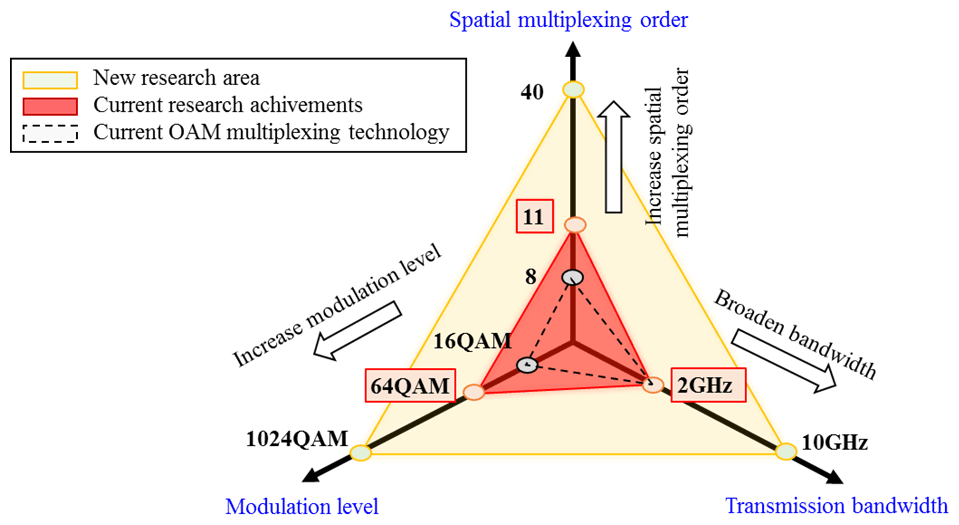
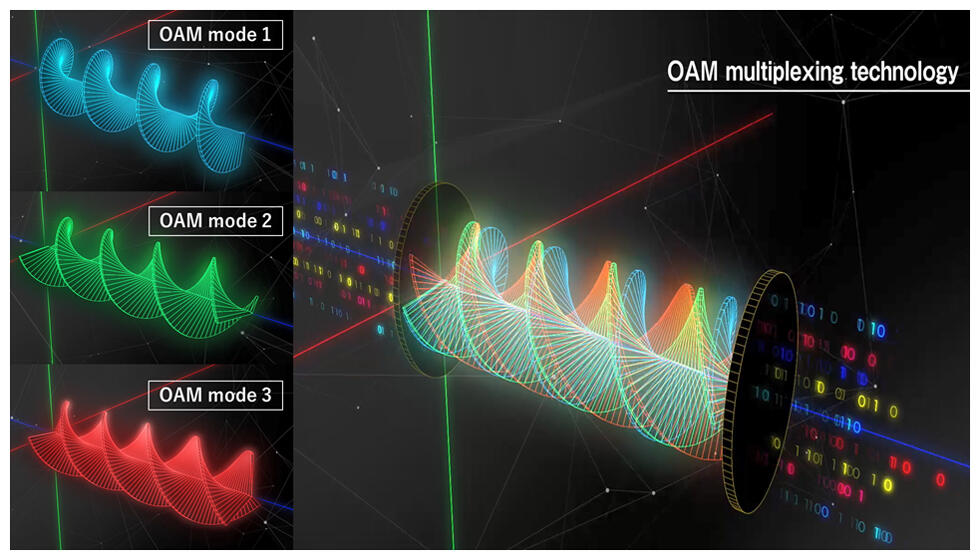
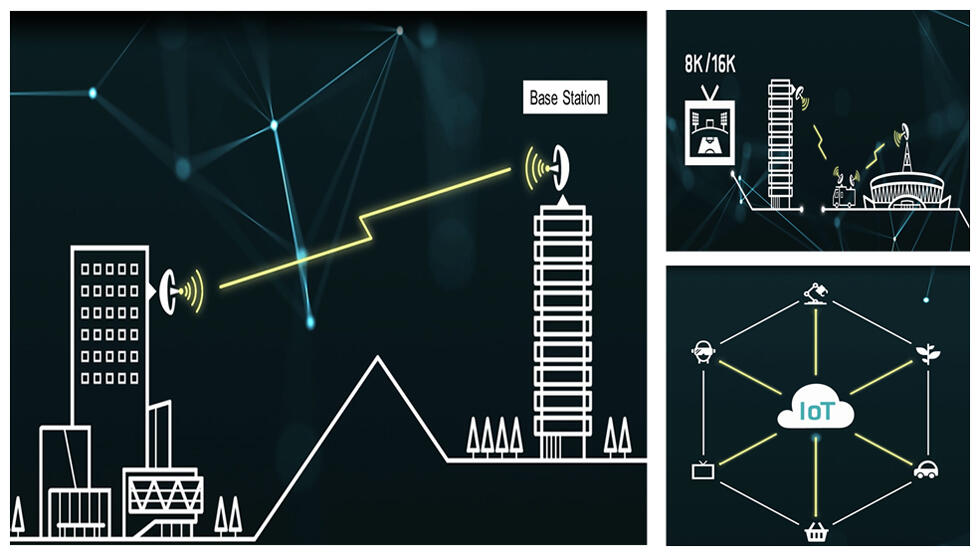
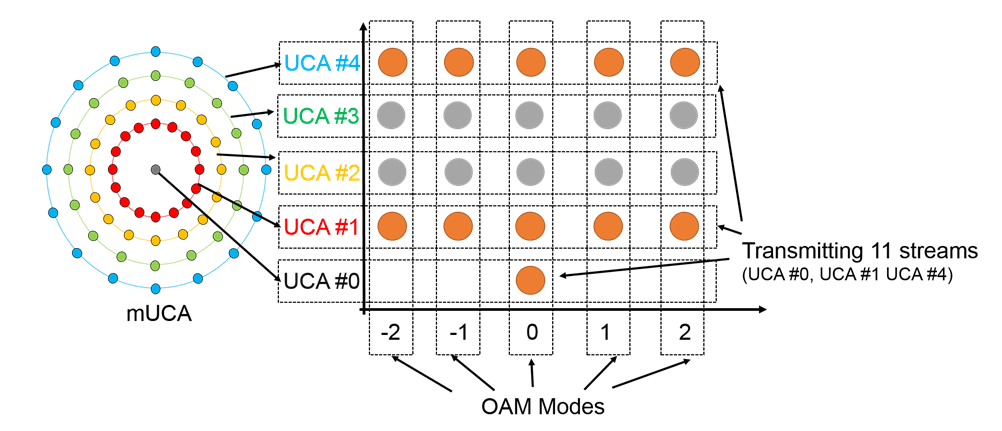
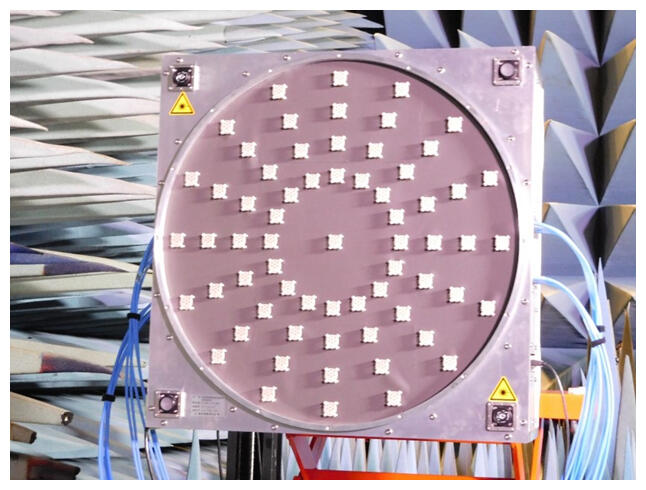
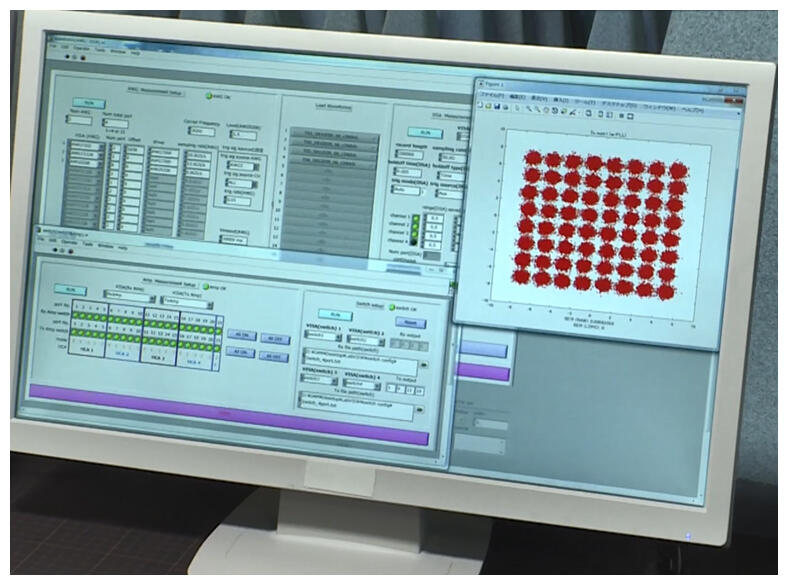
Glossary
- Spatial multiplexing
This is a signal multiplexing method that sends and receives multiple data streams in parallel by using multiple spatially independent electromagnetic waves. - Millimeter waves, quasi-millimeter waves
Millimeter waves have extremely short wavelengths of 1 mm - 10 mm and feature strong rectilinear propagation similar to that of microwaves. They correspond to a frequency band of 30 GHz - 300 GHz. Quasi-millimeter waves refer to radio waves with wavelengths that, at several cm, are close to those of millimeter waves. They are also called radio waves in the 10 GHz - 30 GHz frequency band. - Orbital Angular Momentum (OAM)
OAM is one type of angular momentum possessed by electromagnetic waves expressing the product of positional coordinates and conjugate momenta. Since electromagnetic waves having different OAM are orthogonal to each other and uncorrelated, they can be superposed and independently separated. - Multiple-Input Multiple-Output (MIMO)
MIMO is radio signal processing technology for improving the quality of communications by using multiple antennas at both the transmitter and receiver. It has attracted the attention of the wireless communications industry since it can greatly improve throughput and transmission distance without having to increase bandwidth or power. - Uncompressed 8K/16K
Indicates video having a resolution 8 times (8K) or 16 times (16K) that of conventional Full HD.
Contact information
Nippon Telegraph and Telephone Corporation (NTT)
NTT Science and Core Technology Laboratory Group
Public Relations Section
science_coretech-pr-ml@hco.ntt.co.jp
Information is current as of the date of issue of the individual press release.
Please be advised that information may be outdated after that point.
NTT STORY
WEB media that thinks about the future with NTT











